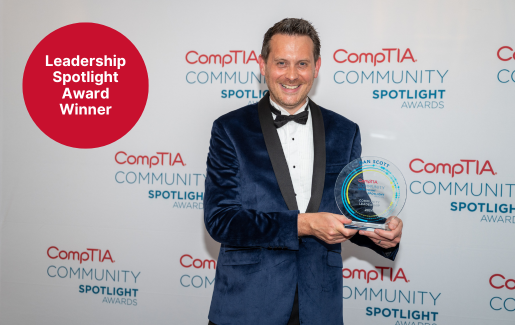 Most of us can agree that your people are an integral part of your success. A high-functioning team with a collaborative culture is the dream—and it can be a reality. But first, you have to address the fact that people value different things. And often those values vary across the different generations that you employ. Learning how to address multigenerational needs can positively affect your people and your company.
Most of us can agree that your people are an integral part of your success. A high-functioning team with a collaborative culture is the dream—and it can be a reality. But first, you have to address the fact that people value different things. And often those values vary across the different generations that you employ. Learning how to address multigenerational needs can positively affect your people and your company.
In a ChannelCon 2024 session titled Addressing the Needs of a Multigenerational Workforce, a panel of industry veterans discussed the complexities of managing and integrating the diverse needs, expectations and work styles of Baby Boomers, Gen X, Millennials and Gen Z. The discussion focused on remote work, keeping employees engaged and hiring based on skill set versus experience.
Which Generation Wants to Work Remotely?
All of them. If there is one thing that everybody can agree on, it’s that working remotely is a huge perk. For the most part, candidates across generations are looking to work from home. While there are individuals in specific roles that may not be the best suited to work from home, moderator Robert Forget, chief revenue officer, Credivera, encouraged MSPs to give it a try, adding that adaptability and accountability are important for both the employee and the employer.
Related Content: How to Make the Office a Magnet, Not a Mandate for Employees
“At the end of the day, if employees are assigned clear KPIs, it gives them room for autonomy and the world of flexibility opens up to them and may open the eyes of MSPs as well,” he said. “My takeaway to MSPs is to give it a try, we’re all troubleshooters.”
Working remotely is a trend that doesn’t seem to be going away. To attract and retain employees across generations business leaders should embrace the new normal by supporting remote employees with comprehensive training and documentation.
“I have a team of 16 that are all remote,” said Ted White, IT recruiter, Vertical Talent Solutions. “Everything starts with the interviewing and onboarding process. Putting an emphasis on documentation up front and having a robust training program helps.”
When remote employees feel that level of support, concerns like organic knowledge transfer diminish.
“People on my team jump on a Slack huddle or Zoom call and work together like they used to in-person,” said Cynthia Schreiner, senior director, community and events, CyberQP. “If you are trying to pull people into the office, make sure you have something collaborative going on, so you don’t have the frustration of thinking ‘I could have done this at home.’”
How Do Different Generations View Job Satisfaction?
It’s common for Baby Boomers to have worked for just a few companies in their working lifetime. The same goes for Gen X. But Millennials and Gen Z have different perspectives. In fact, according to a Gallup report on the millennial generation, 21% of millennials surveyed report changing jobs within the past year—more than three times the rate of other generations.
Similarly, Gen Zers are exploring a variety of positions, careers and even industries. Being somewhat unattached offers the opportunity and flexibility to make their own schedule and make money over multiple side hustles.
“The generation before us valued job loyalty and in-office experience,” said Caitlyn Jopp, vice president of community and engagement, Channel Program. “But long gone are the days when you can leave the office at the office. When you have your laptop in front of you it’s very hard to turn off, and that can lead to burnout and job hopping.”
One solution to preventing burnout is offering flexible work hours, ample paid time off and professional development, she said. “We have to look more at what is important to individuals and how we can adapt our company culture.”
For younger, more entry-level employees, the emphasis should be put on the career path, White said. And if there isn’t one, create one.
“I would also emphasize the importance of the investment of staying with the company for at least three years,” he said. “Target candidates that have been with their current company for about three years. The idea is they know how to go through the good times and the bad times. It’s a prediction of how long you can expect them to be at your company.”
Remembering that the conversation goes both ways is equally important.
“Find the balance of what is good for the company and what is good for the individual,” Jopp said. “Encourage dialogue and tailor it to the individual you’re working with, regardless of their age.”
Are Skills More Important Than Traditional Experience?
Forget noted that overall the industry is starting to see more skill-based hiring versus more traditional experience-based hiring. Is this a generational shift?
Related Content: Skills Assessment and Development Playbook for MSPs
“People see gaps on resumes and make assumptions,” said Schreiner, noting her personal gap is that she stayed home with her kids for a while. “But I realized there are a lot of things I did during that time that are skills that make me better at the job I do now.”
Jopp added that how employers write job descriptions can unintentionally deter people who have resume gaps, or don’t have a college degree.
“Make sure you’re writing job descriptions that allow all types of people to apply as we venture into this multigenerational workforce. The traditional postings don’t work anymore,” she said.
While it’s probably a combination of skills and experience that tell the whole story, White noted that asking employees what they like to do can help you hire the right folks.
“If you ask someone what their interests are you can gauge where they want to go. Let them know they have options to go down different paths,” he said.
Bridging the generational gap doesn’t have to be as complicated as it sounds. When you remember that we’re all people it simplifies things quite a bit. The key is identifying what your people value and finding ways to support and reward those beliefs.
Collaborate across generations.
Learn about the CompTIA Community Mentorship Program.

 Add CompTIA to your favorite RSS reader
Add CompTIA to your favorite RSS reader

